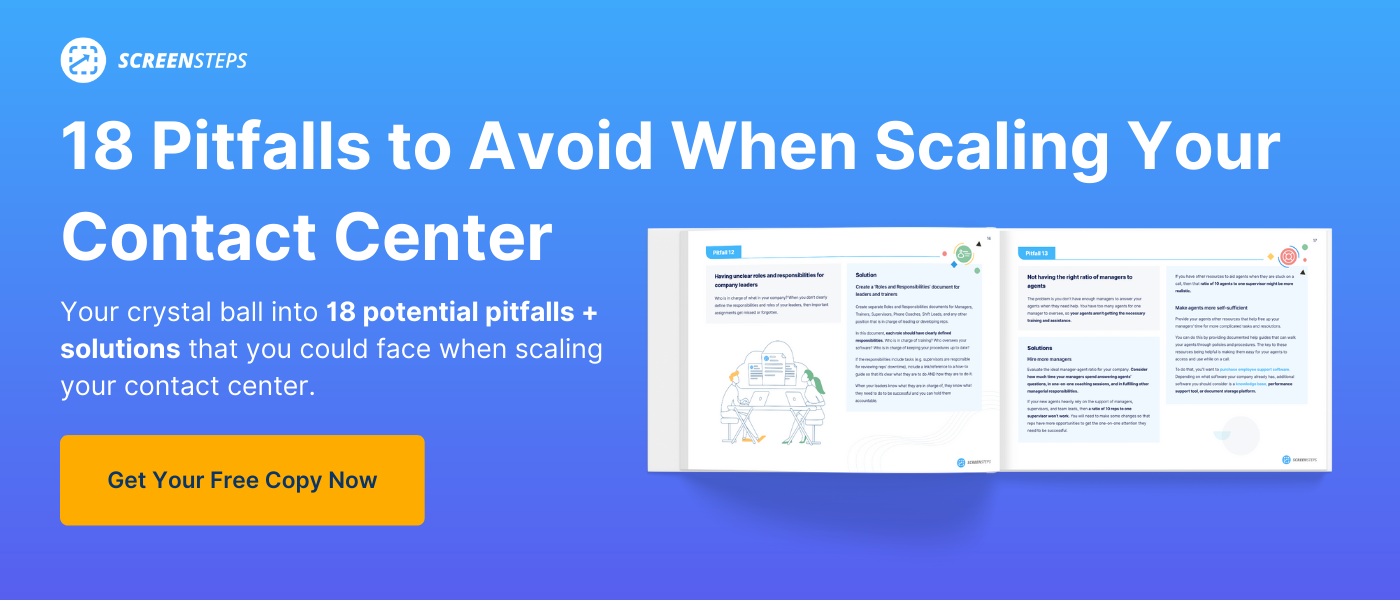11 Metrics to Measure Call Center Agent Performance (+ Formulas)
Whether we mean to or not, we score everything in life.
In school, we receive grades for how much we understand and remember the lessons. With sports, we score performances. Even in social media, we have opportunities to rate things with a thumbs up or thumbs down.
These scores provide context for where we are in life and where we could go. The same applies to business operations, specifically in call centers.
When you are in the customer service industry, your customers are always rating their experience. Then you have internal measurements for how you are doing. Those are all to help you identify your strengths and weaknesses.
Working for ScreenSteps — a knowledge base software company that supports call centers — I’ve recognized the pressure put on call center managers and agents to be perfect. (An impossible task.)
Luckily, call center KPIs (key performance indicators) can help agents individually and the call center as a whole grow.
Below, I provide 11 key metrics to track in your call center as well as provide formulas so that you can calculate how you are performing.
Note: Some of these metrics reflect more on your call center as a whole while others can be attributed specifically to individual agents.
1. Average Speed to Answer (ASA)
The Average Speed to Answer (ASA) measures the time that a caller spends in the queue waiting for an available agent to answer.
ASA does not include the amount of time a caller spends in an IVR system.
How to calculate
Calculate the ASA by totaling the total amount of seconds your callers spent waiting to get in contact with an agent for a specific time period. That could be a day, a week, or a month. Then divide that total by the number of calls that time accounts for.
Average Hold Time = Total # of seconds customers spend on hold/Total # of Calls
2. Average Handle Time (AHT)
The Average Handle Time is the average amount of time an agent is spending on a call. This number is calculated from the second the agent answers the call until the agent hangs up. It includes hold times as well as after-call tasks.
AHT is a tricky metric because you are trying to strike the perfect balance between keeping the call short and fully resolving the caller’s questions.
This metric is a good indicator of an individual agent’s performance. If an agent has too high or low of an AHT, you’ll want to look at other key indicators to ensure their customer service is satisfactory.
How to calculate
Calculate the AHT by totaling the amount of time spent talking, putting the caller on hold, and performing after-call tasks. Then divide that total by the number of calls the agent handled. You can also calculate this metric for your whole call center team.
Average Hold Time = (Total Talk Time + Total Hold Time + Total After-Call Work Time)/ # of Calls
3. Average After-Work Time
The Average After-Work Time measures how long it takes an agent to perform tasks after they get off a call. These tasks typically involve finishing up notes about what was communicated during the call.
For individual agents, this metric can help identify inefficiencies in the agents' post-call habits.
How to calculate
Calculate the Average After-Work Time by totaling how much time an agent spends following a call completing post-call tasks. Then divide that number by the number of calls.
(Total Time Finishing After-Work Tasks)/(Total # of Calls) = Average After-Work Time
4. First Call Resolution (FCR)
The First Call Resolution Rate (FCR) — also known as First Contact Resolution — indicates whether the purpose of a call was resolved the first time a customer called in. This means the customer didn’t need to call back to ask follow-up questions or ask for more support.
As an industry, FCR is important because it saves time and money as call center agents don’t have to repeat the call intake process with a customer multiple times for the same issue.
Use FCR to evaluate an agents’ efficiency. This metric can be paired with Average Handle Time.
If an agent is spending too short of time on a call with a customer and the customer is calling back for the same problem, the agent may need to be trained to ask more questions in order to resolve the call the first time around.
How to calculate
Calculate the FCR rate by identifying the total number of issues reported on a first call. These should be part of the agent’s post-call notes. Then divide that number by the number of calls different agents had with a customer on the same issue.
Total # of Reported Issues Resolved on First Call / Total # of Calls
5. Calls Handled
The total number of customers that an agent talks to during a specific time frame is how you determine the number of calls handled. This does not include the number of abandoned calls.
You can measure the number of calls handled by agents as well as by interactive voice response (IVR).
How to calculate
Calculate the number of calls handled by a specific agent by totaling the number of calls handled in a designated time frame (i.e. an hour, a day, etc.) Subtract any abandoned calls from the total.
Total # of Calls Answered - Total # of Abandoned Calls = Calls Handled
6. Call Abandonment Rate
The Call Abandonment Rate accounts for the number of callers who hang up before they are ever able to reach an agent.
Across the industry, an abandonment rate of around 5% is considered acceptable. When your abandonment rate is high, it indicates that customers were on hold for too long. This often is a sign of customer frustration and can lead to a loss of trust in your brand.
How to calculate
To calculate your Call Abandonment Rate, first, calculate the number of calls minus the number of calls your agents handled. Then divide the number by the number of calls. Multiply that answer by 100% to get the abandonment rate percentage.
Call Abandonment Rate = (# of Calls - # of Handled Calls)/# of Calls X 100%
7. Average Hold Time
The Average Hold Time calculates the amount of time a caller is placed on hold during a call.
When agents forget how to perform a procedure and have to ask a question or search for an answer, they often place callers on hold. The Average Hold Time measures the amount of time a caller spends waiting on an agent.
How to calculate
Calculate the Average Hold Time by totaling the number of seconds in a given time frame (ex: the month of November) that the customer spends on hold. Then divide that number by the total number of calls.
Total # of Seconds a Customer Spends on Hold / Total # of Calls
8. NPS scores (Net Promoter Score)
The Net Promoter Score (NPS) is a customer satisfaction survey conducted by a third-party business. It gauges your customers’ experiences.
The survey relies on a single question: “How likely are you to recommend this company?”
Customers respond to the question by ranking the call center on a scale from one to 10. The ratings mean:
- Promoters (9-10)
- Passives (7-8)
- Detractors (0-6)
Overall, this score is given companywide.
How to calculate
Your NPS score is calculated by subtracting the percentage of Detractors scores you received from the percentage of Promoter scores you received. The Passive ratings don’t affect the score.
NPS = % Promoters - % Detractors
9. Customer Satisfaction Score (CSAT)
Another form of gauging the customer’s experience is the Customer Satisfaction Score (CSAT). A CSAT question is asked at the end of a customer survey with a five-point scale. The question simply asked how satisfied the customer was with the call.
Responses range from 1 (unsatisfactory) to 5 (very satisfied). When calculating satisfied customers, include scores of 4 (satisfied).
How to calculate
The CSAT scores are given on a scale of 0 to 100%. Calculate your CSAT score by totaling the number of “satisfied” (4 ratings) and “very satisfied” (5 ratings) customer responses. Divide that number by the number of survey responses. Multiply the total by 100 for your percentage.
# of Satisfied Customers (4 & 5) / # of Survey Responses * 100%
10. Cost Per Call (CPC)
The Cost Per Call helps call centers estimate how much each call is costing them.
This KPI helps you determine how effective your call center is. It can help call center managers understand costs and decide how to distribute the budget for resources.
How to calculate
Calculate the CPC by totaling the costs of all calls. That includes employee wages, benefits, training, software, etc. Then divide that number by the number of calls. Choose a specific time frame to set parameters for this calculation.
CPC = Total Cost of All Calls / Total # of Calls
11. Occupancy Rate
Occupancy Rate is the total amount of time a call center agent spends working, meaning the amount of time they spend on a call with customers or performing tasks related to those calls.
This is a good metric for individual agents. A low occupancy rate is an indication that the agent isn’t taking full advantage of their work hours.
Maybe your agent is taking longer breaks, has formed bad habits, or spends time on unnecessary tasks. Or maybe you have too many meetings or training sessions on their schedule.
How to calculate
Calculate Occupancy Rate by totaling the amount of time an agent spends handling a call. Then divide that number by the total number of hours they logged. Multiply that number by 100 to determine the percentage of time spent occupied with job-related tasks.
(Total Contact Handling Time / Total Logged Hours) X 100%
How to improve call center agent performance
Call center metrics and KPIs help you determine areas of weakness in agent performance. You can use your call center metrics to help your call center agents improve their performance.
The ScreenSteps knowledge base helps call center agents improve performance by making your call flows, policies, and procedures accessible. Interactive help guides are stored in one location where it is easy for agents to find the information they need in as few as two clicks.
There are many ways to help agents improve their performance once you’ve identified their weaknesses. Read this article for seven ways to help improve call center agent performance.




